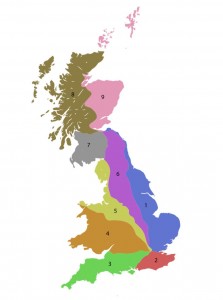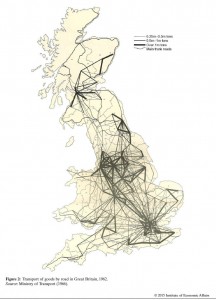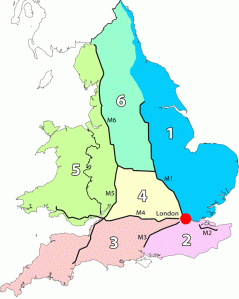I apologise for the erratic blogging. My inclination to blog is rather like the hurried lover – it comes and goes.
I’m currently taking a bit of a holiday, visiting my relatives in Kent. I’ve been up to London a few times, and it looks like Boomtown, with cranes and new skyscrapers dominating the skyline. It’s been like that the last few years, as if the Great Recession didn’t hit the Capital as hard. Indeed, London and the Home Counties are very much the economic engine of the country.
It wasn’t always this way. Back when Britain was the workshop of the world, there was a more diverse economic geography. Steel from Sheffield. Ships from Glasgow. Cotton from Manchester. Coal from Newcastle.
As with all mature economies, Britain’s has moved from manufacturing to services and the economy has become much more concentrated – with high-value financial and professional services being clustered mainly around London*.
I partly think this is inevitable, but another part of me disagrees. I came across this post on Diane Coyle‘s excellent The Enlightened Economist blog.
Here’s a map of the planned motorways built from the late 50s onwards**:
 They all extend radially from London, like the spokes on a bicycle wheel. Did the distribution of traffic justify designing the motorways like this? Here’s a map showing freight patterns in the early 60s:
They all extend radially from London, like the spokes on a bicycle wheel. Did the distribution of traffic justify designing the motorways like this? Here’s a map showing freight patterns in the early 60s:
 Looking at this, it would seem most freight travelled within regions – London and the South East as one region, the West Midlands and the Northern industrial cities as the other. Rather than a single hub at London, there perhaps should have been two hubs: one connecting the South East and one in North West England connecting Birmingham, Manchester, Liverpool, Sheffield and Leeds together.
Looking at this, it would seem most freight travelled within regions – London and the South East as one region, the West Midlands and the Northern industrial cities as the other. Rather than a single hub at London, there perhaps should have been two hubs: one connecting the South East and one in North West England connecting Birmingham, Manchester, Liverpool, Sheffield and Leeds together.
It would seem that government decisions have helped create a London-centric economy.
This is all history now, but it poses questions for the High Speed Rail being proposed. HS2 will first connect London to Birmingham, then branch into two, with one branch heading to Manchester, the other to Leeds. The proposed HS3 would then connect Liverpool to Hull, via Manchester and Leeds, if it gets approved, but this would be very far off.
Are we making a similar mistake with rail as we did with the roads: prioritising a link to London over all else? Jim O’Neill, formerly of Goldman Sachs, now a Treasury minister looking at devolution to cities outside of London, agrees. Expressing skepticism over HS2, he says:
“I’d put it down as a nice luxury. It’s not obvious to me that it’s going to be useful to the north or the Midlands because all it guarantees is that people can get to London quicker than they can now.”
Instead he wants a cutting-edge transport network between cities such as Liverpool, Manchester, Sheffield and Leeds:
“It’s like creating the equivalent of a tube system. That’s way more valuable to the country.”
Maybe Lord Jim has a point?
* The North Sea oil industry around Aberdeen brings a lot of prosperity to that region, and there are other pockets of prosperity – in Bristol and Cheshire, for instance. This interactive map shows where the most valuable goods and services have been produced in recent years.
** Which incidentally gave the motorways their name:


Yes these are all valid points. The Regions are sometimes choked because there is not enough lateral communications. The money on HS2 and 3, might well be better invested in boosting other parts of the Uk, instead of making journeys to London 20 minutes faster or thereabouts.
Pingback: London’s Skyline | Steven Clarke's Blog